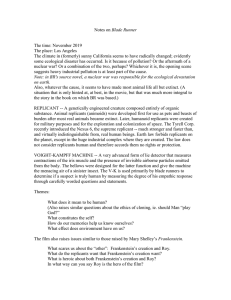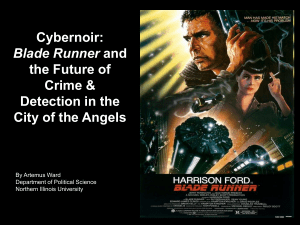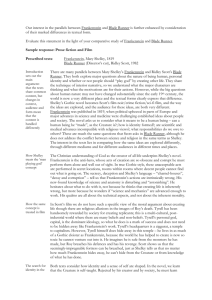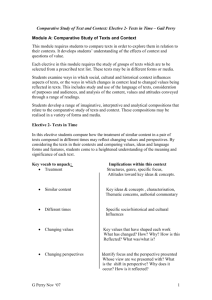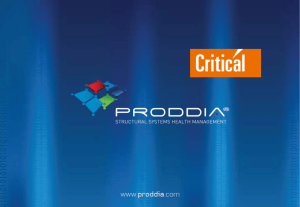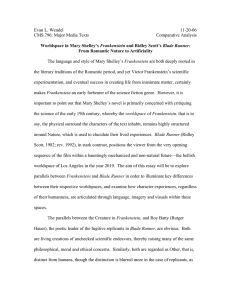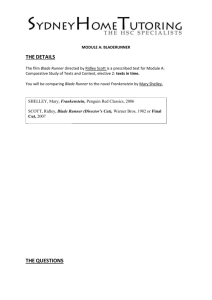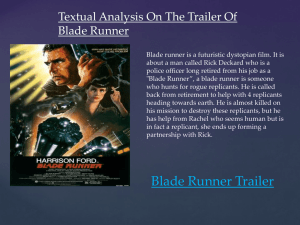humans and machines “Blade Runner”
advertisement
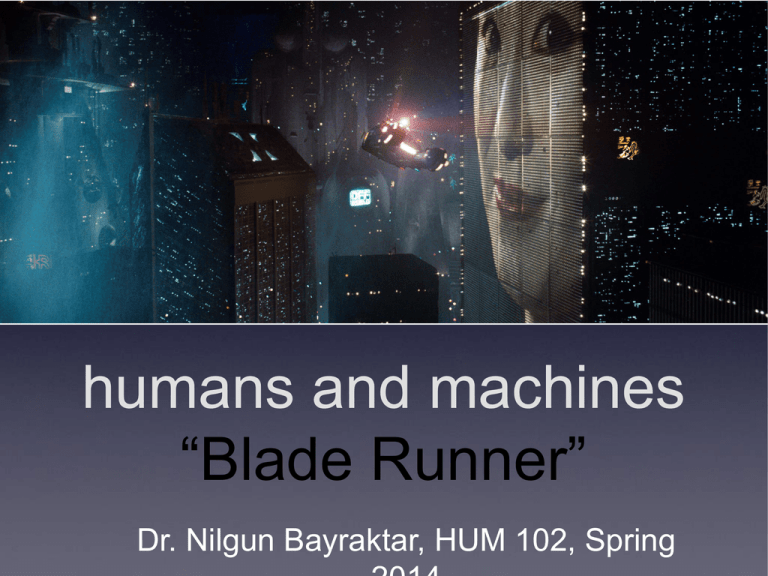
humans and machines “Blade Runner” Dr. Nilgun Bayraktar, HUM 102, Spring questions... • What constitutes human? • • • What does it mean to be human? What are the boundaries between humans and machines, humans and nonhumans, living and nonliving, inorganic and organic? Can these boundaries collapse or become unclear? If so, what happens as a result of the blurring of the boundaries between humans and machines? • • Frankenstein myth: a tale of “perverted” science? Mary Shelley’s Frankenstein: often interpreted as a popular symbol of concerns over the risks and dangers of science and technology (the dangers of “messing with nature” or “playing God”) Is the “monstrous” creature an image of our failure to control science and technology? • • • is the creature made monstrous... by his unnaturalness? (body parts taken from several corpses, stitched together to form a different being; artificially-created life by a man) because Dr. Frankenstein transgresses natural or Godgiven boundaries? because Dr. Frankenstein abandons the creature, unprepared, to a hostile world, taking no responsibility for his work? METROPOLIS (1927) by Fritz Lang • silent science fiction film set in the year 2000 in a futuristic city • • depicts a society given over to the powers of science and technology and ruled in a coldly rational manner very important for its striking visual images of modern anxiety over technology and urbanization Robotic Maria • • • Lang’s image of a robotic Maria embodies a duality of technology’s attractions and subversions I- Robotic Maria’s seductive power played out in its dance before the city’s elite, and the ease with which she lures the workers into rebellion II- A force of destruction and potential human replacement Blade Runner (1982) • dystopian science fiction film directed by Ridley Scott • loosely based on the novel Do Androids Dream of Electric Sheep? by Philip K. Dick • set in Los Angeles in November 2019 Blade • combines genresRunner... of science fiction and film noir • cyberpunk: associated with the dark visions of the near future on earth, where humans are under the influence of various technologies (electronic, informational, genetic), making it virtually impossible to distinguish between the real and the artificially replicated • For the cyberpunks, technology is visceral, pervasive and utterly intimate. Not outside us, but next to us. Under our skin; often, inside our minds. Blade Runner... • • Rick Deckard is a former member of a special police force called “blade runner” replicants: genetically engineered organic robots exclusively used for dangerous, menial or leisure work on off-world colonies; their use on Earth is banned; they are “retired” (executed) by blade runners if they are seen on Earth • • • • • film noir generally focuses on urban crime and corruption a dystopic city; a mystery; a detective figure; and a bleak-fatalistic tone low-key lighting; claustrophobic framing; shadows/reflections; unbalanced compositions uncertainty as a central theme mostly about violations: vice, corruption, dark film Blade Runner’s 2019 Los Angeles (City of Angels) no nature visually and acoustically intrusive wealthy people have left for off-world colonies Alienating and degrading The city is a gloomy, rainy, commercially driven, multiethnic megapolis disembodied eye universalizing, godlike perspective? eye imagery • • • The bursting flames seem to suggest a world of terror and violence The potential for volcanic eruption (outburst of violence) seems to lie just beneath the surface of this city A metaphor the for a dilemma of human definition and identification uncertainty of vision • In Blade Runner, the more we see, the more our uncertainty grows. • Its world features a profusion of simulations: synthetic animals, giant view screens, replicants, memory implants and faked photos... replicants: monsters or “more human than humans”? Leon Rachel Roy Pris Zhora replicants • • • Entirely biological creatures, designed by genetic engineers to be “off-world” slaves on space colonies. They are designed to copy human beings in every way except for their emotions. They have a four-year life-span. replicants... • • • • denied autonomy and the chance to fulfill their desires kept working as slaves not allowed to return to earth—under penalty of death cannot be assimilated into the old codes of human definition (expansion of the definition of the human?) The Voight Kampff Test The test establishes a surveillance method that makes it possible to qualify, classify, and punish. The Voight Kampff Test • • • • determines the presence or absence of the subject's humanity by examining the fluctuation of its retina when certain emotions are provoked the replicant’s eye is assumed to be incapable of registering empathy and therefore incapable of representing human other feelings? (i.e. alienation and fear) does the screened eye signify the human? implanted memories • • • Replicants are programmed with memories to make them indistinguishable from humans. Photographs: visual images of these artificial memories; fundamentally connected to what they depict. The tangibility of the photograph creates a substitute history. Creator-Creation • Both Frankenstein and Blade Runner explore the emotional dynamics between a creator and his creation • Roy Batty, confronts his Maker in hopes of receiving from him the gift of an increased life-span • Limits of human knowledge? A Cyborg Manifesto • Donna Haraway, describes differentiating between human and machine as a “leaky distinction,” since “late twentieth century machines have made thoroughly ambiguous the difference between natural and artificial, mind and body, self-developing and externally designed, and many other distinctions that used to apply to organisms and machines. Our machines are disturbingly lively, and we ourselves frighteningly inert.” • "A Cyborg Manifesto: Science, Technology, and Socialist-Feminism in the Late Twentieth Century," 1991.
